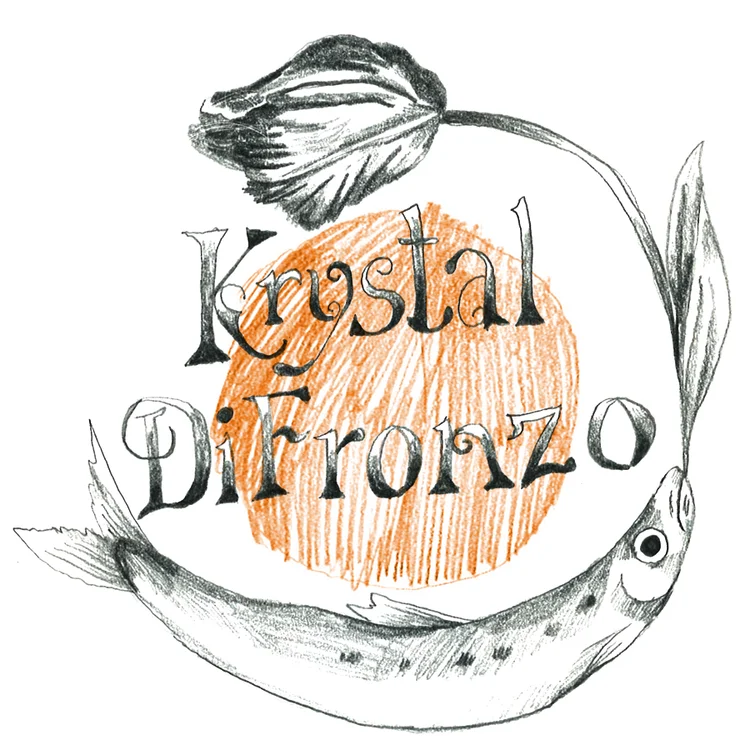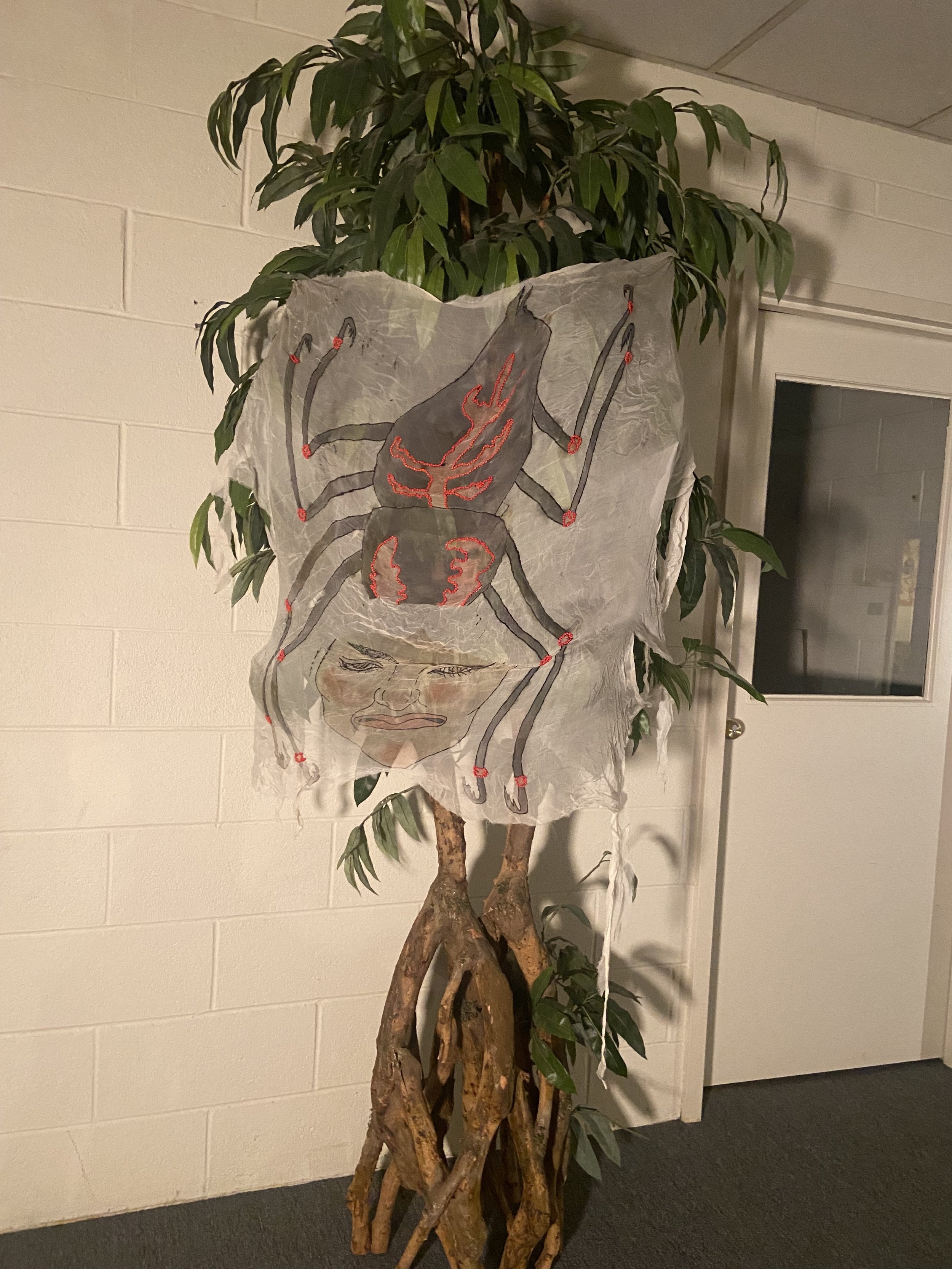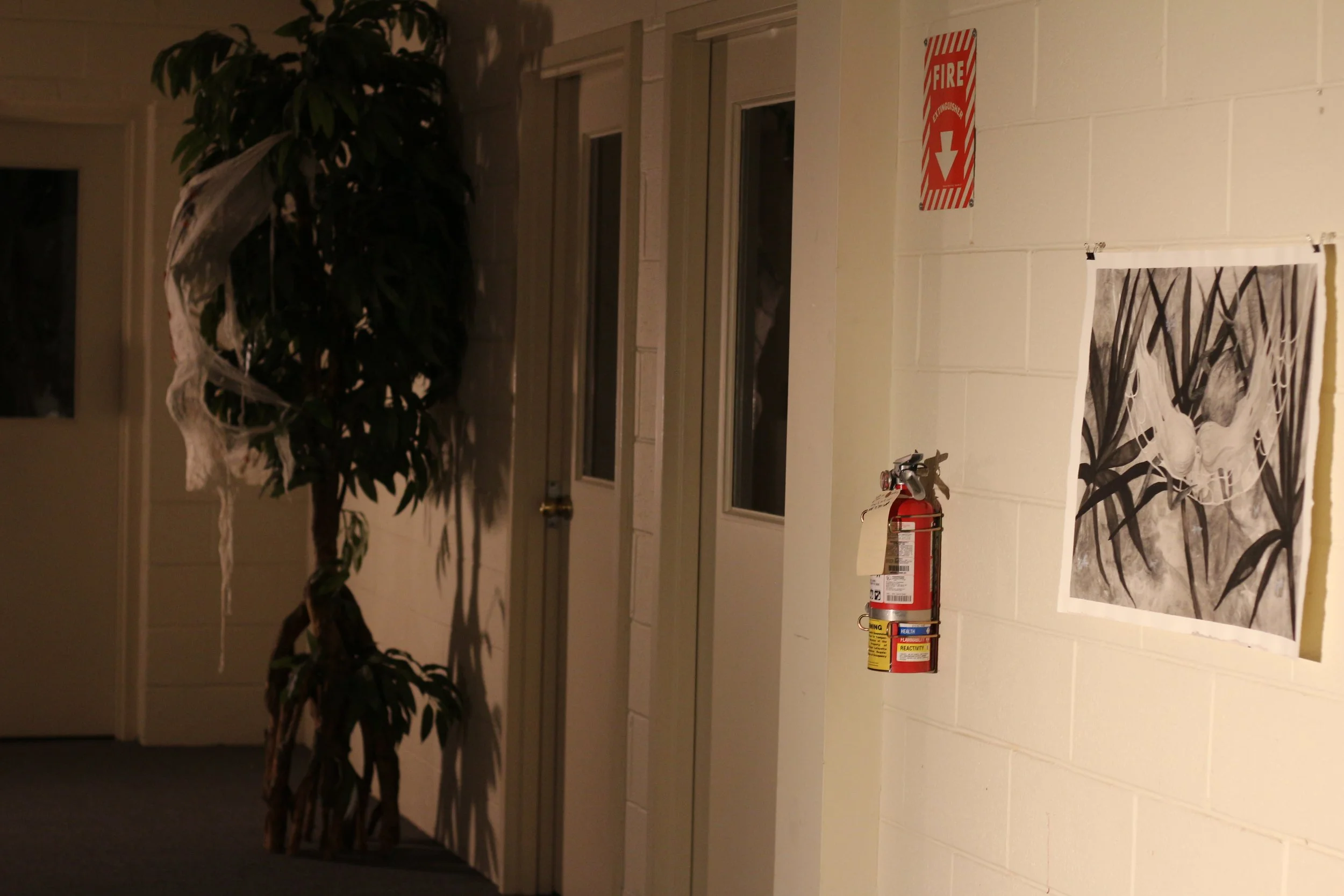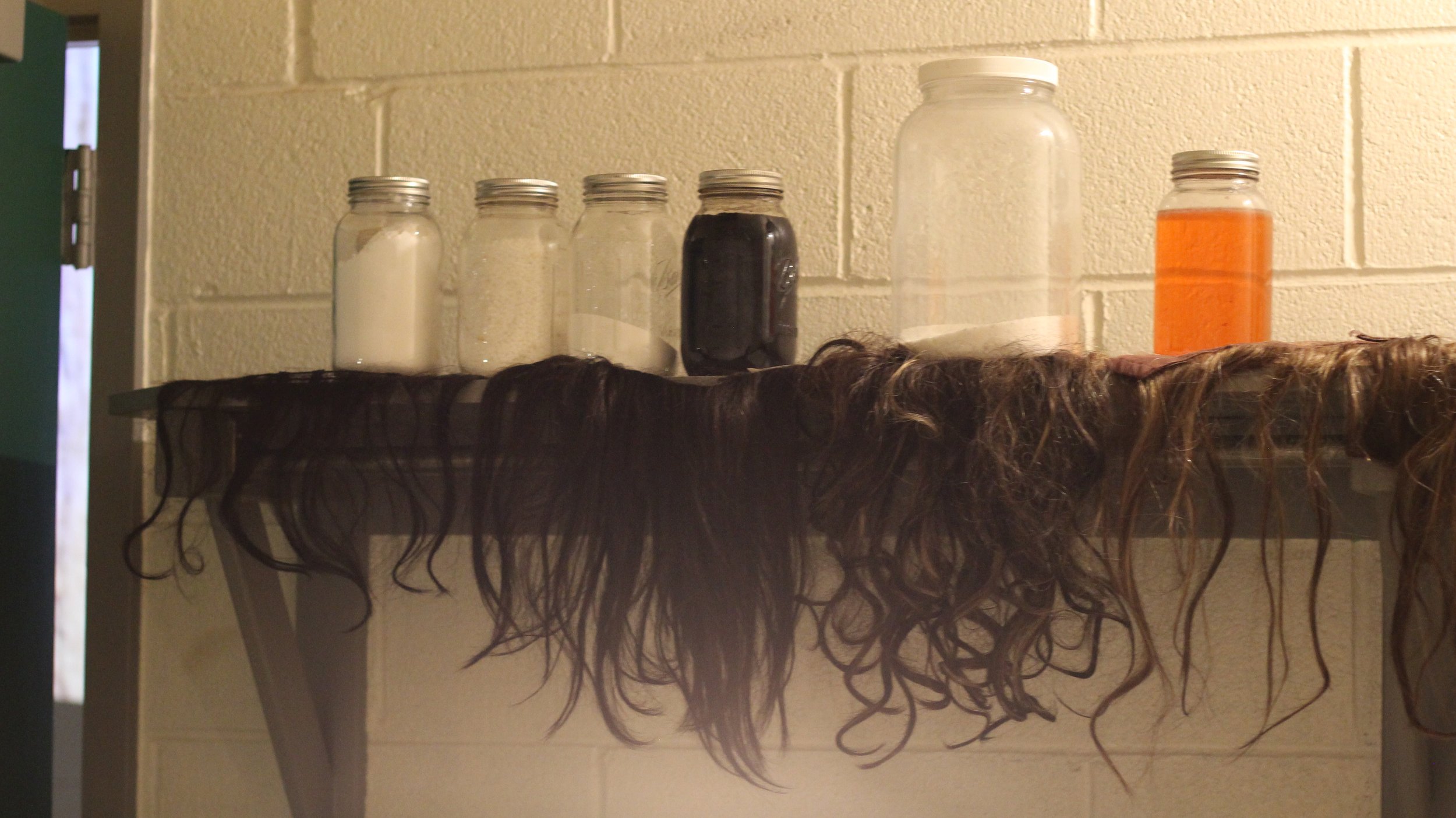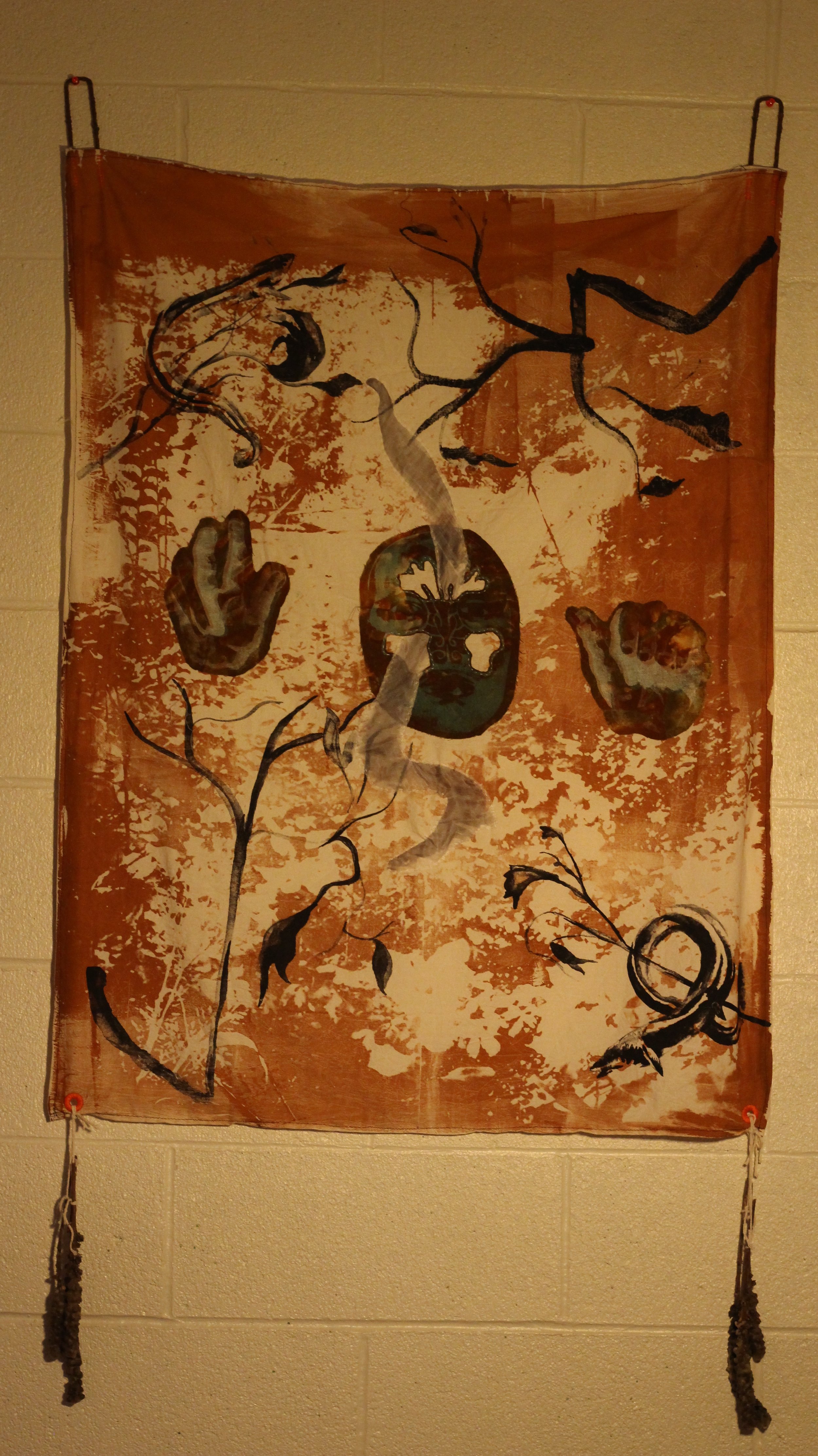An installation at Green Street Galleries at Lafayette College in Easton, PA. This space also served as my studio during my residency at the Experimental Printmaking Institute. Taking this into account the exhibition acted as a slippery hybrid between open studio and site-specific installations. All works were made in 2021, most during my time there.
The exhibition consisted of five distinct spaces: the studio, the loom room, the hallway, the kitchen and the bathroom.
I see this body of work as reactionary. After a turbulent year, I found myself in the Lehigh Valley with the opportunity to reflect and absorb. Looking towards the difficult future of digging through psychic sediment, these works serve as protection in the form of trusted icons or as an act of extraction in the form of known poisons
The Studio
Specter Weaver, natural dyes on silk gauze, glass beads
Cimaruta & Cracked Web, dead dough and peppercorn
The cimaruta is a Southern Italian charm intended to ward off the evil eye. It represents a branch of the herb, rue (sacred to the goddess Diana). Each section ends in an amulet: a four-leaf clover, a crescent moon, a rooster's head. A range of icons all intended to protect.
Saw Through Palmetto, charcoal and ink on paper
With A Bright Gleam, cyanotype on cotton muslin with glass beads and embroidery
I am a crafter of silken webs. The white luminous gauzes, so quick to tear on the weft but not in the warp, are soaked in hot water and Castile soap and then hung to dry on the line. As I pin these sheets to dry I notice someone else has made their home on the very same lines. Three individual webs housing it’s own spider. My muses, my three graces. Each one the same electric hue that only finds its harmony here in the swamp where everything else is the same surreal brightness. It’s the same shimmer of metallic silver, neon green and orange one finds on a fishing lure at a Bass Pro Shop. Ones with names like Swedish Pimple or Blue Fox Foxee Jig that are coated in that oil that smells like iron and wounded prey.
The Loom Room
On and off for about a decade, I’ve been making images out of the grid of warp and weft. A fun bit of Freud’s was the idea that women were motivated to plait hair and weave thread because it was an attempt to hide the shame they felt towards their “genital deficiency”, the lack of a phallus. The matting down of pubic hair.
I’ve been hesitant to get back into the slippery net of innards that is plucking image and meaning out of trauma. This summer was haunted by the actions of multiple generations of fathers like a set of stacking dolls with something tightly coiled and venomous at the center.
In this house, in this body, we clear all the vermin out of the cracks. We smoke them out with damiana, we wash the floorboards with tears, we eat diner pancakes with our mother at 7 am delirious from making new urgent blueprints.
Summer of 2021 I finally see Louise Bourgeois’ The Destruction of the Father (1974). Louise, as always, her sharp compressed glass truth. The dried orange rind with the surprise pith dick, the dinner table set with latex body parts, I see the works as endless circular revelations of what it means to partially contain the blood of the father. The spiral, the constant turning in on oneself, the neurotic search for language. The same brand of neurosis that has me staring at the ground on my self-regulated daily 4 mile please Krystal let’s gain some energetic momentum walks looking for black walnuts to then crack and boil to turn wool the color of my roots to render hair in string. Just like Freud suggested.
The Hallway
I Reject Thee Foul Beezelbub!, inkjet print and video projection
In Easton, I am living in the top story of an old Victorian home, complete with a little sunroom. I begin to notice a couple of flies one day. The next week I am killing flies every ten minutes or so and notice their bodies scattered along the floorboards when I return weekly from New York. They begin to madden me. The buzz feels like a type of echolocation, I can hear their circular paths as they make their way through my studio apartment. One second they are by the kitchen, the next they fly by my ear tiny wings setting some animal nerve in my brain alight. Deep down my biology tells me flies=rot=death=you are unsafe.
I ask the man whose house I am living in, “What is the deal with these flies? Where are they coming from? Is some vermin dead in the attic?” He assures me that these flies are not corpse flies rather cluster flies. In the fall they are merely trying to get inside of houses to have their babies and die.
The Kitchen
The work in this kitchen reflects the nature of the tools embedded into the architecture and how they served me during my residency. I used the functioning stovetop to render dyes and melt beeswax. The hair was all donated to me by my mother, a wigmaker. It is a space of self-reflection, of seeing one’s mother in their face, and the overwhelming act of care.
Flooded Weir, screen print on silk and cotton muslin, black walnut, steel supports from the Delaware Lehigh trail post Hurricane Ida, hag’s torches (mullein and beeswax)
This work is to be understood in three parts: the sinus, the river, the eel.
1.) The cavities behind the eyes and cheeks have long given me grief. At the slightest barometric shift I wake up with an irritating head ache. I inherited these faulty caverns from my father who also had septum issues. So strange how the change of atmospheric pressure affects the air in these caves of the face. In a body that is mostly water, mostly a vessel, the hollows becomes a unique instrument.
2.) Easton, PA is located on the intersection of three waterways: the Delaware River, the Lehigh River, and Bushkill Creek. The second week teaching classes were cancelled because the rains following Hurricane Ida caused the Delaware to rise to the flood point. I hiked up the large hill I live on to try and get a better view of the river’s swollen banks. I couldn’t see it’s entirety through the tree line but I saw her moving thick, brown, and fast. The sound of her rushing blended with the wind and it was unreal seeing the violent waters instead of skyline through the mass of branches.
3.) I’ve long been fascinated with eel fishing since watching The Tin Drum as a teenager. The infamous scene where a horse’s head is brought out of the water and fishermen pull masses of eels from the orifices of the skull is an image burned onto me. There is an uncanniness to the eel, not quite fish not quite worm, an uneasy creature. In researching the Delaware River I was surprised to hear that it had the highest population of the only species of freshwater eel in the Americas that is also threatened. I read about Ray Turner, a 73 year old man who has spent most of his life living in a cabin on the Upper Delaware in New York catching eel in a traditional weir trap and smoking them. A weir is a fence-like structure (Turner builds his with stone) that are constructed across river ways. I drove up to Ray’s smokehouse the other day to buy some of his eel and was heartbroken to hear how this year his traps have been completely destroyed due to the rising water levels. A dance tragically thrown out of rhythm.
Moon Dog Shroud, screen print on cotton and silk, polyester gauze gift bags, glass beads, ribbon, dried lemons
The base of this curtain is pieced together from tiny polyester organza gift bags my mother mailed me. The net on top is the looped cords. She compulsively sends me packages mostly containing things she no longer uses but feels I may need one day. The mark is usually missed but the sentiment is there. This need to care from afar.
She also sends me tins of oily fish. Not that they are any cheaper in the Midwest (and not to mention the shipping cost), just to make sure I’m feeding myself.
I’ve read that the first child most resembles the father as evolutionary tactic to determine heredity so that the risk of abandonment is lessened. This has failed me and I’m becoming more delighted to see the bits of her that shine through in the way my body performs, her anxious drive, and her fierce care.
The Bathroom
Along with the kitchen, the bathroom struck me with its untouched fixtures from the 1960s. There was an uneasiness in the air caused by the inclusion of a shower and an old built-in ashtray full of cigar butts. The shame of the public restroom carries the body of work in this space. Again, The Tin Drum is referenced through the characters of Maria and Agnes. They both reflect the fear of motherhood, a deep-seated taboo terror that has always sat in me as a queer body always at odds and dysphoric about my reproductive functions.
Our Lady Agnes, series of three screen prints with black walnut ink on madder root painted paper.
Patron saint of a hunger so big it severs the cord of the mother. Swallowing that which disgust ravenously rather than carry her partner’s offspring. A death through consumption, choking down trash fed fish with a ferocity. I love her. Her stare into oblivion while mechanically spooning creamed eel down her throat pierces me.
Loosened Lips, Stuck Throat, cluster flies, vodka, glass bottle, beeswax, West German anatomical model of the throat and thyroid
The smell of vodka is an immediate gag trigger for me caused by trauma. Salvia begins to pool in the mouth, the throat contracts. The cluster flies collected off the floor of my studio apartment, a constant reminder of the endless animal cycle of breeding, feeding, and death.
Our Lady Maria, dye on silk gauze, shower curtain rings
The hysteric, flawed effort to rid the body of another’s genetics.
